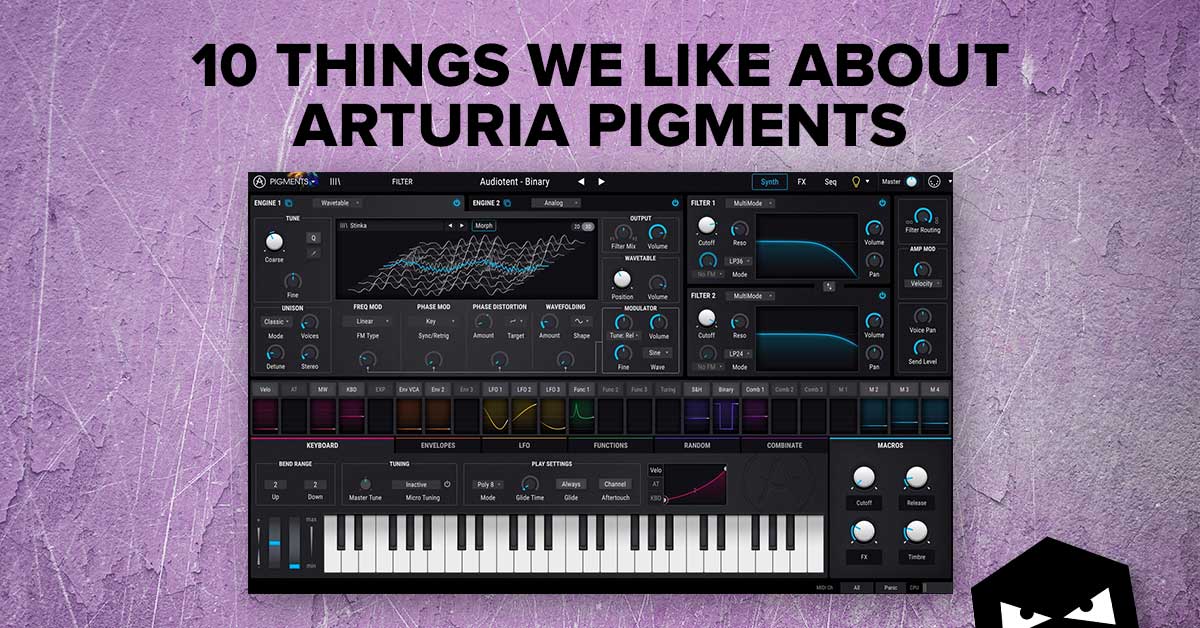Arturia Pigments
Pigments by Arturia is a ‘Polychrome Software Synthesizer’... we are not sure if that is a legit synthesiser category or Arturia claiming a niche for this unique synth, either way, it's a beast! Arturia decided to make their first software synthesiser that is not based on a real-world classic synth, they have taken all the best bits from previous releases, all that knowledge and expertise to build something that is both familiar and uniquely forward-thinking.
Pigments boasts two synth engines (analog and wavetable) that can be stacked and swapped out, tons of filter options, ridiculously vast modulation options, powerful step sequencer and 13 brilliant studio-quality FX. In this article, we will share our top 10 favourite things about Arturia Pigments!

1. The ability to stack two synth engines
Most synthesisers have one synth engine, usually analog, digital or wavetable. Pigments gives you the ability to stack two synth engines but also lets you decide whether you want two analog engines, two wavetable engines or a combination of both, giving you the best of digital and analog in one sound.The analog engine features three oscillators with classic wave shapes, a noise oscillator, FM section and a drift knob which adds instantly pleasing analog goodness.
The wavetable engine can do some pretty complex wave shaping, but at the same time, it is super intuitive, even for those that are new to wavetable synthesis. There is no deep menu diving all the controls are right there on the front panel, which enables quick programming and easy sound manipulation.


2. The filter section is AMAZING!
Maybe Arturia has taken a leaf out of U-he’s book here, you can swap out the filter type and each filter has its own mode options. The reason why this is so good, is that Arturia have added some of the best sounding analog filters from past releases such as SEM, Matrix 12 and Mini. The filter section also comes with a standard analog multimode filter. It doesn’t end there, underneath the top four options are four digital filters, these are surgeon, comb phaser and formant. Love both the analog and digital flavours? Well, you can use both at once, with the option to add in a second filter. These can be assigned to each synth engine separately, combined in series, or blended to taste. You can even pan the filters differently to each other for some cool stereo trickery.

3. A massively complex modulation matrix that is easy to program
The first thing to point out about the modulation matrix is that everything is there visually on the front panel. You can easily see the waveforms for the modulations, and which ones are active. When hovering over the tabs, Pigments will darken all parameters apart from the ones that are been modulated. Click on the tab and it will show you all modulations from that source, from there you can easily switch them off or change the depth amounts. Sending modulation to parameters is super easy, click on the tab and then adjust modulation amount on any parameter. The best thing about this is that you can very quickly assign multiple modulations. This is something that can be quite a time-consuming task on other synths.

4. A brilliant sounding FX section with great routing options
Usually, you may feel the need to reach for external effects when shaping synth sounds, but Pigments gives you enough routing options and effect modules to create full-sounding patches inside the plugin. There are two FX busses for insert FX that have three slots each. They can be daisy-chained in series, allowing a stack of 6 insert FX, or you can run them in parallel. If that wasn’t enough to efficiently sculpt sounds, Pigments also has a send and return option, which can house 3 more effect modules. That is 9 effect slots in total! For example, you could have delay, reverb and chorus on the return slots. The remaining 6 insert slots can be used to shape your sound with distortion, saturation, compression, eq and filtering.
The FX section allows for easy swapping of the modules, great for trying out different routing options. You can also save your favourite effect settings, user presets can be later accessed in the drop-down menu.


5. The Functions mod source is fantastic!
The 3 function mod sources are multi-segment envelope generators, basically an extremely tweak-able LFO/Envelope generator. If you are familiar with Native Instruments Massive or XFER Serum, you will be well accustomed to this type of envelope generator. Although this is nothing completely new, envelope editing in Pigments is super intuitive and easy to program. The function source also includes the option to change the play mode, which can be changed to either one-shot, loop or run. Gate source can also be switched from keyboard to a satisfying array of options including the sequencer, LFO, the other function sources and turing (which we will talk about later!). You can also save custom shape presets for later use and there is a random function, which provides random shapes for instant inspiration!

6. The oscillators can be quantised to scale.
This is a small feature but a cool one! By clicking the Q and pen button, you can edit a scale for the oscillators which can then be assigned to the mod wheel. This would allow you to play up and down a scale just using a mod wheel, have a go its great fun! It can be a superb source for inspiration if you are trying to create some unique leads for your music.
7. It has one of the best onboard sequencers that we’ve used!
Firstly, the sequencer is one of the easiest to program that we have used on a synth VST, no fiddly drop-down menus or clunky controls. The sequencers can be easily programmed using the sliders to change the trig values. Apart from ease of use, the sequencer is packed with awesome features. Such as the ability to randomise trig values, add trig probability, change rate divisions and create polyrhythms. Another great feature, is the ability to quantise the scale for the sequence!
8. The arp has some great extra features.
As well as the usual modern arp features such as swing, random, rate and arp mode, the arp also shares the same features as the sequencer. You can sequence the octave, velocity, trig probability, gate length and slide. Like the sequencer, you can also change the rate divisions for each sequencer, create polyrhythms and add randomness. Adding in the sequencer features makes this arp ridiculously powerful compared to most onboard synth arps. By playing around with all the settings mentioned, you should be able to come up with some really interesting melodic grooves.
9. If you like using randomness in your music, you will love Pigments.
So we’ve already mentioned quite a few areas which you can randomise certain elements within Pigments, the ability to randomise some wavetable features, LFO’s, function shapes and sequencer/arp values. Randomisation doesn’t end there, by clicking on the random source tab you will have access to three random sources that can be routed to multiple destinations, making Pigments the ultimate random machine! As well as the classic sample and hold option (with added extras), Pigments has two extra mathematical random sources. One is called binary that works with one's and zero's, basically an on/off random generator.The other is called turin, which can be completely random or locked into loops that repeat every cycle, which can be adjusted and flipped. The sample and hold generator is a traditional random generator, but Arturia have added some unusual features, such as the ability to change the impulse source and trigger source. The rise and fall options are also a nice touch, which allows shaping of the random waveforms.

10. Combinate is geeky overkill, but also an interesting source of experimental creativity.
Skipped maths at school? Don’t worry about it too much, but don’t skip this section of Pigments! Read the manual and your head will be in bits trying to understand how combinate calculates the resulting LFO shapes. It doesn’t matter too much, as long as you understand the principles of what combinate does.Combinate generates new and interesting modulation sources, based on the interactions of one or two other modulation sources. Select the source, which is the parameter being affected. Next select the mod, which is the parameter that will affect the source. Type decides the math process that will be applied and amount affects how much the mod affects the source. Play around with this and see what interesting mod source shapes you can generate.

Congratulations, you made it this far!! We trust you found this information insightful and informative. If you haven't tried Arturia Pigments out yet we recommend you download the demo version from the Arturia website and give it a test.
If you already own Pigments, click here to learn more about our 107 preset bank called BINARY. Download and see what the synth is capable of!












Leave a comment
This site is protected by hCaptcha and the hCaptcha Privacy Policy and Terms of Service apply.